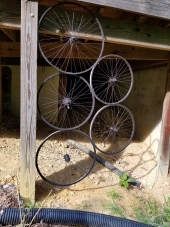




Dan Fish wrote:I too will dump my ash bucket in my driveway and report back if anything of note happens.
Eric Hanson wrote:Andrea,
As the wine caps break down the woodchips they establish a rich colony of various microbes, microbes which help to feed the plants. Were you to establish wine caps early, they will wrap themselves around the tree roots and feed them. Something I found about my project was that wine caps grew best when plant roots were available. I pulled a couple of small plants out of my garden and their roots were intertwined with wine cap mycelium. And those plants were extremely healthy themselves.
I imagine that if you were to start a colony of wine caps (or a host of other mushrooms, but wine caps are just so easy) then they would get established with the tree roots and help it grow. Like I said earlier, if you don’t like mushrooms, don’t eat them (I imagine that I would not like the taste of manure, but the plants certainly like the stuff!). It is worth growing for what they will do for the plants themselves.

Peter Sedgwick wrote:
Satamax Antone wrote:Peter, do you have strawbales available nearby in the summer.
Hey Satamax,
Probably not bales per say. Will have to look into it. Do have access to rice straw. Just not sure how much in the spring as the rice cropping season is in the early fall.
Been considering a simple pole frame structure with the timber we have here. Double studded small structure with some sort of stem wall and straw light clay infill on top.
This topic is definitely a conversation for another thread. I’ll start to put some ideas together and make a new topic.
Eric Hanson wrote:Andrea,
Feeling really ambitious? You could try to plant comfrey about 18”-2’ away from the tree itself, the comfrey is a nice companion plant and it’s leaves will drop and provide a nice chop and drop fertilization.
Feeling even more ambitious? Try inoculating those woodchips with wine cap mushrooms. You will likely want to start with a layer of chips at least 4-6 inches thick, spread the wine cap spawn, water and wait. The comfrey should provide a bit of shade for the wine caps, and the wine caps will turn your woodchips into amazingly fertile compost filled with healthy microbes! Even if you don’t want the mushrooms, the compost they leave behind is amazing. Best of all, the peach tree, comfrey and wine caps all form a synergistic relationship. I try to incorporate wine cap mushrooms into just about every corner of my garden and fruit patches.
Eric
Marco Banks wrote:Peach trees grow great on heavy clay soil. I've got 5 peach trees, all doing fantastic and our native soil is brick material. At least it used to be brick hard, but after years of mulching with wood chips, its amazing.
Mulch, mulch, mulch, mulch, mulch. Wood chips.
As you put wood chips down, the soil becomes lighter and drainage improves exponentially. That's the secret to a thriving orchard on heavy clay soil: mulch. Plant your tree and then put down 8 inches of wood chips all around it. In six months, add another 8 inches because those chips will bread down quickly.
Mihai Ilie wrote:Biggest danger on your land is not your lack of experience but the deers.
Read about how to protect the young trees from the deers .
Do not entirely follow the guidelines that you see on the label when you buy a tree.You can sometimes plant them closer especially if the soil is rich and has good moisture retention.
I have doubts that you ordered trees from a nursery and they sold you non grafted varietyes.Basically 95 % of the trees sold in nurserryes are grafted.
You could post pictures here and i will be glad to help you with somme advice.
Mihai Ilie wrote:Paw paw is a nice tree to have and tolerates shadow ( young trees actually need shade or elese they get sunburned).
I would plant cherryes,apples,red fleshed apples ,pears almonds,hazelnuts,apricots ,quince if you like to cook with them and all soird of temperate fruits not necesarely native like the paw paw.
Grafted trees if you want high quality fruits.I have manny seedlings not geafted that i make moonshine from the fruits because they are not too palatable.
James Landreth wrote:I agree with Mihai's suggestions and will add that you can plant them in a mound, mixing looser soil with the clay, gradually transitioning to the pure native soil. This will help especially during wet times. I know of a woman who grows peaches in a swamp in Georgia this way!